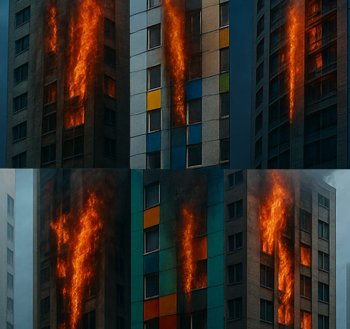Float glass
Contents |
[edit] Introduction
Float glass (sometimes referred to as clear float glass) is glass that that has been manufactured from molten glass floated on the surface of a heated liquid of greater density such as tin (or in the past, lead) and then cooled. The result is a smooth glass of uniform thickness that gives undistorted vision, high light transmission and optical clarity.
Float glass is the most widely used form of glass for consumer applications. While in a semi-molten, waxy state, it can be easily shaped and formed to suit a variety of uses. Once made, it can be further processed to create other types of specialist glass, such as toughened glass, laminated glass and acoustic glass.
[edit] Manufacture
The first commercial application of the float glass process (the ‘Pilkington process’) of forming a continuous ribbon of glass floated on a molten tin surface was devised in the mid-1950s by Sir Alastair Pilkington and Kenneth Bickerstaff at Pilkington Brothers in the UK. The glass was flattened by its self-weight and flowed through the process under the influence of gravity. However, it was not until 1960 that the bulk process was made a commercial success.
The raw materials that go into float glass mainly include silica sand, soda ash, limestone and other ingredients. Once mixed, the materials are fed into a furnace with any recycled glass that may be included and heated to as high as 1,500°C to become a molten mass. It is then cooled before being poured into a tin bath.
Smoothness on the metal side is imparted by contact with the molten tin and on the upper surface (the air side) by polishing with fire. No additional polishing is required. Poured onto the molten tin in ribbons at an initial temperature of around 1,200°C, the speed of the glass through the process can be left to gravity or by top roller gears on the glass surface propelling it forward.
At around 1,100°C, the glass enters a lehr oven to be annealed i.e allowed to cool very gradually. This controlled cooling allows any internal stresses in the glass to dissipate. When it emerges from the oven, the glass is further cooled by jets of air after which scanners seek any imperfections which, if found, will result in the glass being discarded or recycled. Once at room temperature, the glass is trimmed and cut to suit customer requirements, after which the sheets are packed for shipping.
[edit] Applications
Because it results in a perfectly flat surface, float glass can be used in most flat-glass applications. It is available in a wide range of sizes and thicknesses for use in mirrors, automobile applications, windows, doors, insulated glass, light fittings and so on.
[edit] Related articles on Designing Buildings
Featured articles and news
Delivering for tenants; National Retrofit Hub
New report offers recommendations to strengthen energy efficiency standards to protect private renters.
Government consultations for the summer of 2025
A year of Labour, past and present consultations on the environment, the built environment, training and tax.
CMA competitiveness probe of major housing developers
100 million affordable housing contributions committed with further consultation published.
Homes England supports Greencore Homes
42 new build affordable sustainable homes in Oxfordshire.
Zero carbon social housing: unlocking brownfield potential
Seven ZEDpod strategies for brownfield housing success.
CIOB report; a blueprint for SDGs and the built environment
Pairing the Sustainable Development Goals with projects.
Types, tests, standards and fires relating to external cladding
Brief descriptions with an extensive list of fires for review.
Latest Build UK Building Safety Regime explainer published
Key elements in one short, now updated document.
UKGBC launch the UK Climate Resilience Roadmap
First guidance of its kind on direct climate impacts for the built environment and how it can adapt.
CLC Health, Safety and Wellbeing Strategy 2025
Launched by the Minister for Industry to look at fatalities on site, improving mental health and other issues.
One of the most impressive Victorian architects. Book review.
Common Assessment Standard now with building safety
New CAS update now includes mandatory building safety questions.
RTPI leader to become new CIOB Chief Executive Officer
Dr Victoria Hills MRTPI, FICE to take over after Caroline Gumble’s departure.
Social and affordable housing, a long term plan for delivery
The “Delivering a Decade of Renewal for Social and Affordable Housing” strategy sets out future path.
A change to adoptive architecture
Effects of global weather warming on architectural detailing, material choice and human interaction.
The proposed publicly owned and backed subsidiary of Homes England, to facilitate new homes.
How big is the problem and what can we do to mitigate the effects?
Overheating guidance and tools for building designers
A number of cool guides to help with the heat.
The UK's Modern Industrial Strategy: A 10 year plan
Previous consultation criticism, current key elements and general support with some persisting reservations.
Building Safety Regulator reforms
New roles, new staff and a new fast track service pave the way for a single construction regulator.

























